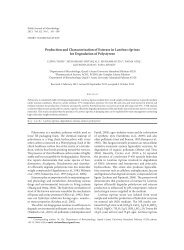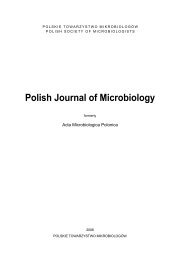No 3 - Polish Journal of Microbiology
No 3 - Polish Journal of Microbiology
No 3 - Polish Journal of Microbiology
Create successful ePaper yourself
Turn your PDF publications into a flip-book with our unique Google optimized e-Paper software.
190<br />
Integration<br />
site<br />
Strain Exogenous<br />
Element<br />
factors (VF) and screening <strong>of</strong> 21 phage and ICE integration<br />
sites. The described PCR based method combined<br />
with emm typing can be effectively used to differentiate<br />
between GAS strains.<br />
Experimental<br />
Materials and Methods<br />
Bacterial isolates. Over 650 highly diverse GAS<br />
isolates analyzed in the study were sent to KORLd<br />
(National Reference Center for Antibiotic Resistance)<br />
and KOROUN (National Reference Center for Infections<br />
<strong>of</strong> Central Nervous System) as a part <strong>of</strong> routine<br />
reference activity and as a part <strong>of</strong> BiNet network for<br />
monitoring invasive infections (http://www.koroun.<br />
edu.pl/binet_info01.php). Bacterial strains were sent<br />
from over 60 laboratories located in multiple geographical<br />
areas <strong>of</strong> Poland and were isolated from various<br />
forms <strong>of</strong> the GAS diseases (throat, skin and invasive<br />
infections). Emm types <strong>of</strong> the strains were determined<br />
as routine part <strong>of</strong> diagnostic work according to (Beall<br />
et al., 1996) and CdC’s recommendations. In addition,<br />
we used highly clonal population <strong>of</strong> strains which PFGE<br />
patterns, emm and ST types were previously determined<br />
(Szczypa et al., 2004).<br />
Borek A.L. et al. 3<br />
Virulence<br />
Gene(s)<br />
CdS Start <strong>of</strong> the<br />
integrated element<br />
Table I continued<br />
CdS Stop <strong>of</strong> the<br />
integrated element<br />
M MGAS6180 6180-Rd.2 R28 1302 1337<br />
N MGAS315 315.5 speA3 1300 1354<br />
N SSI SPsP2 speA3 0507 0561<br />
N Manfredo man.1 spd3 0471 0535<br />
N MGAS10394 10394.6 sda 1338 1366<br />
O MGAS315 315.6 sdn 1408 1458<br />
O SSI-1 SPsP1 sdn 0408 0456<br />
P MGAS5005 5005.3 sda 1414 1467<br />
P MGAS2096 2096.2 sda 1440 1492<br />
P MGAS9429 9429.3 sda 1415 1468<br />
P MGAS8232 8232.5 sda 1745 1808<br />
R MGAS10394 10394.7 spd3 1540 1562<br />
S MGAS10750 10750-Rd.2 erm(A) 1679 1719<br />
T SF370 370.4 none 2122 2147<br />
T MGAS10270 10270.4 none 1874 1896<br />
T MGAS10750 10750.4 none 1897 1921<br />
T Manfredo man.5 none 1764 1779<br />
T MGAS10394 10394.8 none 1804 1824<br />
T MGAS6180 6180.3 none 1789 1813<br />
U MGAS10270 10270.5 none 1917 1951<br />
U MGAS6180 6180.4 none 1840 1864<br />
PFGE. PFGE analysis was performed according to<br />
modified method by Stanley and co-workers (Stanley<br />
et al., 1995). Briefly, agarose plugs containing bacteria<br />
were incubated for 4 h at 37°C in lysis buffer with lysozyme<br />
(100 µg/ml, Sigma) and mutanolysin (40 µg/ml,<br />
Sigma), followed by overnight treatment with proteinase<br />
K (1 mg/ml). dNA embedded in plugs was digested<br />
with SmaI (Fermentas) for 4h, and separated at 14°C<br />
for 22 h in CHEF-dR III system (Bio-Rad) in 0.5x TBE<br />
buffer, with 6V/cm, initial pulse 1 s., final pulse 30 s.<br />
Isolation <strong>of</strong> chromosomal DNA. Chromosomal<br />
dNA was isolated from cells grown overnight on<br />
Columbia agar plates supplemented with 5% sheep<br />
blood (BioRad, BioMerieux) using the Genomic<br />
Mini Ax BACTERIA kit (A&A Biotechnology) or the<br />
Genomic Mini kit (A&A Biotechnology) according to<br />
the manufacturer’s protocol, with additional initial cell<br />
wall digestion with lysozyme (1 mg/ml, Sigma) and<br />
mutanolysin (500 U/ml, Sigma) for 30 min at 37°C, in<br />
the presence <strong>of</strong> RNAse. Chromosomal dNA used as<br />
a template for PCR reactions was diluted 10-fold.<br />
Primer design and specificity tests. Primer pairs<br />
were designed using the modified Primer3 s<strong>of</strong>tware,<br />
available as the Primer-BLAST tool at NCBI (http://<br />
www.ncbi.nlm.nih.gov/tools/primer-blast/). Primers<br />
were designed to conserved regions <strong>of</strong> detected genes<br />
(in case <strong>of</strong> virulence factors) or conserved regions






